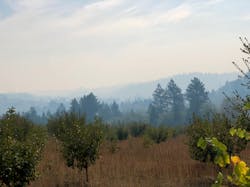PG&E Cleared in 2017 Tubbs-Fire Probe, to Enhance Safety Measures
The devastating and unprecedented wildfires of 2017 and 2018 in California left a blaze of death and destruction. The California Department of Forestry and Fire Protection (CAL FIRE) was mobilized to scrutinize the October 2017 Tubbs wildfire. CAL FIRE recently completed its probe and concluded that the Pacific Gas and Electric Co. (PG&E) was not responsible for causing the fire.
The vast loss of lives, homes and businesses during these devastating wildfires is heartbreaking and PG&E recently announced its commitment to help affected communities recover and rebuild after the calamity. The utility has announced its decision to reassess existing infrastructure facilities to further enhance safety measures to protect all customers from the ever-increasing threat of wildfires.
Regardless of the announcement, PG&E still faces extensive litigation, significant potential liabilities and a deteriorating financial situation, which was further impaired by the recent credit-agency downgrades to below investment grade. Resolving the legal liabilities and financial challenges stemming from the 2017 and 2018 wildfires will be enormously complex and will require the company to address multiple stakeholder interests, including thousands of wildfire victims and others who have already made claims and thousands of others who are expected to make claims.
Given the continued and growing threat of extreme weather and wildfires, and as an additional precautionary measure, PG&E is enhancing and expanding its Community Wildfire Safety Program to further reduce wildfire risks and help keep its customers and the communities it serves safe. PG&E’s ongoing and expanded safety actions include:
Real-Time Monitoring and Intelligence
- Coordinating prevention and response efforts by monitoring wildfire risk in real time from its Wildfire Safety Operations Center.
- Expanding its network of weather stations to enhance weather forecasting and modeling. By 2022, PG&E will add approximately 1300 new weather stations in high-fire-risk areas.
- Installing nearly 600 new high-definition cameras in high-fire-threat areas, increasing coverage across these areas to more than 90%.
New and Enhanced Safety Measures
- Further enhancing vegetation management efforts with an increased focus on vegetation that poses higher wildfire risk, such as overhanging branches and limbs directly above and around power lines, and tree species at an increased risk of falling into power lines, as well as dead and dying trees.
- Conducting accelerated safety inspections of electric infrastructure in high-fire-threat areas, in addition to routine inspections and maintenance. This includes ground or climbing inspections, as well as aerial imagery captured by drones and in some cases, helicopter, to further complement and enhance visual inspections.
- Taking action right away to address any immediate risk to public safety found during accelerated inspections.
- Disabling of automatic reclosing of circuit breakers and reclosures in high-fire-risk areas during wildfire season.
- Proactively turning off electric power for safety, only as a last resort, when extreme-fire-danger conditions are predicted, and helping customers prepare by providing early warning notification when and where possible.
System Hardening and Resiliency
- Installing stronger and more resilient poles and covered power lines across 7100 miles of highest-fire-risk areas over the course of the next 10 years.
- Replacing equipment to further reduce risk to its system and tailoring upgrades based on terrain and weather conditions using more granular analysis of fire-prone regions.
- Piloting new resilience zones to provide electricity to central community resources serving local customers during a Public Safety Power Shutoff event.
Wildfire Risk Is Growing
California faces an ever-increasing threat from catastrophic wildfires, extreme weather and higher temperatures. Recent state and federal climate assessments warn the threat is only growing. California’s Fourth Climate Change Assessment found the average area burned statewide would increase 77% if greenhouse gas emissions continue to rise. The assessment also said prolonged drought and higher temperatures will triple the frequency of wildfires.
Multiple factors contribute to wildfire risk across PG&E’s service area. These include vast tree mortality following a historic five-year drought. Fire season is now extended because of prolonged periods of high temperatures, extreme dryness, tinder-dry grass and record high winds increasing the number of wildfires and making them more dangerous. More than half of PG&E’s service area is now considered to be in extreme- or high-fire-risk areas as designated by the California Public Utilities Commission's Fire-Threat Map.
